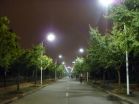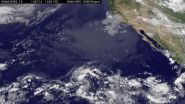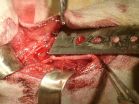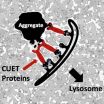(Press-News.org) The 1500 mile Appalachian mountain chain runs along a nearly straight line from Alabama to Newfoundland—except for a curious bend in Pennsylvania and New York State. Researchers from the College of New Jersey and the University of Rochester now know what caused that bend—a dense, underground block of rigid, volcanic rock forced the chain to shift eastward as it was forming millions of years ago.
According to Cindy Ebinger, a professor of earth and environmental sciences at the University of Rochester, scientists had previously known about the volcanic rock structure under the Appalachians. "What we didn't understand was the size of the structure or its implications for mountain-building processes," she said.
The findings have been published in the journal Earth and Planetary Science Letters.
When the North American and African continental plates collided more than 300 million years ago, the North American plate began folding and thrusting upwards as it was pushed westward into the dense underground rock structure—in what is now the northeastern United States. The dense rock created a barricade, forcing the Appalachian mountain range to spring up with its characteristic bend.
The research team—which also included Margaret Benoit, an associate professor of physics at the College of New Jersey, and graduate student Melanie Crampton at the College of New Jersey—studied data collected by the Earthscope project, which is funded by the National Science Foundation. Earthscope makes use of 136 GPS receivers and an array of 400 portable seismometers deployed in the northeast United States to measure ground movement.
Benoit and Ebinger also made use of the North American Gravity Database, a compilation of open-source data from the U.S., Canada, and Mexico. The database, started two decades ago, contains measurements of the gravitational pull over the North American terrain. Most people assume that gravity has a constant value, but when gravity is experimentally measured, it changes from place to place due to variations in the density and thickness of Earth's rock layers. Certain parts of the Earth are denser than others, causing the gravitational pull to be slightly greater in those places.
Data on the changes in gravitational pull and seismic velocity together allowed the researchers to determine the density of the underground structure and conclude that it is volcanic in origin, with dimensions of 450 kilometers by 100 kilometers. This information, along with data from the Earthscope project ultimately helped the researchers to model how the bend was formed.
Ebinger called the research project a "foundation study" that will improve scientists' understanding of the Earth's underlying structures. As an example, Ebinger said their findings could provide useful information in the debate over hydraulic fracturing—popularly known is hydrofracking—in New York State.
Hydrofracking is a mining technique used to extract natural gas from deep in the earth. It involves drilling horizontally into shale formations, then injecting the rock with sand, water, and a cocktail of chemicals to free the trapped gas for removal. The region just west of the Appalachian Basin—the Marcellus Shale formation—is rich in natural gas reserves and is being considered for development by drilling companies.
INFORMATION:
Research funding was provided by NASA and the National Science Foundation.
The paper can be found here: http://www.sciencedirect.com/science/article/pii/S0012821X14002246.
About the University of Rochester
The University of Rochester is one of the nation's leading private universities. Located in Rochester, N.Y., the University gives students exceptional opportunities for interdisciplinary study and close collaboration with faculty through its unique cluster-based curriculum. Its College, School of Arts and Sciences, and Hajim School of Engineering and Applied Sciences are complemented by its Eastman School of Music, Simon School of Business, Warner School of Education, Laboratory for Laser Energetics, School of Medicine and Dentistry, School of Nursing, Eastman Institute for Oral Health, and the Memorial Art Gallery.
The bend in the Appalachian mountain chain is finally explained
A better understanding of Marcellus Shale could inform decisions on hydrofracking
2014-07-18
ELSE PRESS RELEASES FROM THIS DATE:
Immune cell's role in intestinal movement may lead to better understanding of IBS
2014-07-18
Learning the role of immune-system cells in healthy digestive tracts and how they interact with neighboring nerve cells may lead to new treatments for irritable bowel syndrome (IBS). Researchers from Penn State College of Medicine, in collaboration with other scientists, have reported the role of macrophages in regulating the contractions of the colon to push digested material through the digestive tract.
The muscular lining of the intestine contains a distinct kind of macrophage, an immune system cell that helps fight infections. The role of these cells in normal colon ...
It's go time for LUX-Zeplin dark matter experiment
2014-07-18
New Haven, Conn. -- From the physics labs at Yale University to the bottom of a played-out gold mine in South Dakota, a new generation of dark matter experiments is ready to commence.
The U.S. Department of Energy's Office of Science and the National Science Foundation recently gave the go-ahead to LUX-Zeplin (LZ), a key experiment in the hunt for dark matter, the invisible substance that may make up much of the universe. Daniel McKinsey, a professor of physics, leads a contingent of Yale scientists working on the project.
"We emerged from a very intense competition," ...
Improving driver safety: How to prevent streetlight glare in the new world of LED lighting
2014-07-18
WASHINGTON, July 18—Long hours of nighttime driving can cause eyestrain because while our vision adapts to the surrounding darkness, the sudden stabs of brightness from streetlamps can be irritating, distracting and even painful. Even as LED technology has transformed the lighting industry, bringing the promise of more energy-efficient road illumination, some fear that the new lights could cause even more troublesome, unsafe glare.
A team of researchers from China and the Netherlands has developed a way to evaluate the human impact of uncomfortable glare caused by LED ...
NASA sees super typhoon Rammasun eyeing landfall
2014-07-18
Imagery from NASA's Aqua satellite captured a wide-eyed Typhoon Rammasun as it was making landfall in northern Hainan Island, China early on July 18. A rainfall analysis using another NASA satellite showed the flooding potential of the storm as it left the Philippines and headed for China. Now, Rammasun is headed for a final landfall near the northeastern border of Vietnam and China.
On July 17, an analysis of Typhoon Rammasun's rainfall was conducted at NASA's Goddard Space Flight Center in Greenbelt, Maryland. The rainfall analysis covered the storm's rainfall from ...
NASA satellite catches birth of Tropical Storm Wali near Hawaii
2014-07-18
The first tropical cyclone of the season has formed in the Central Pacific Ocean as NASA's Terra satellite passed overhead. Tropical Storm Wali formed southeast of the Big Island of Hawaii, and now that it's nearing, a Flash Flood Watch has been posted for all of the islands.
NASA's Terra satellite passed over Wali on July 17 at 19:55 UTC (3:55 p.m. EDT) just as it was being classified as Tropical Depression 1C. NOAA's Central Pacific Hurricane Center (CPHC) issued an advisory at 5 p.m. EDT (11 a.m. HST) announcing the birth of the depression near 12.7 north and 140.7 ...
A rhesus monkey model of radial nerve injury for evaluating peripheral nerve repair
2014-07-18
Current research on bone marrow stem cell transplantation and autologous or xenogenic nerve transplantation for peripheral nerve regeneration has mainly focused on the repair of peripheral nerve defects in rodents. Dr. Dong Wang and his team, First Affiliated Hospital of Sun Yat-sen University, China established a standardized experimental model of 2.5 cm-long radial nerve defects in rhesus monkeys and evaluated the effect of repair on peripheral nerve injury. The quality of nerve regeneration in the bone marrow stem cells-laden allografts was comparable to that achieved ...
Intranasal nerve growth factor repairs injured spinal cord neurons
2014-07-18
Nerve growth factor can be delivered to the brain by intranasal administration without risk for treatment of brain diseases. Dr. Luigi Aloe, Cellular Biology and Neurobiology Institute, National Research Council, Italy and his team performed a study to investigate whether, by intranasal administration, the nerve growth factor bypasses the blood-brain barrier and turns over the spinal cord neurons. Results showed that at 3 weeks after intranasal administration of nerve growth factor, the contents of nerve growth factor and its receptor in the spinal cord were increased, ...
How does L-carnitine maintain the normal structure of sciatic nerve in crush injury?
2014-07-18
Several studies have demonstrated that L-carnitine exhibits neuroprotective effects on injured sciatic nerve of rats with diabetes mellitus. Dr. Ümmü Zeynep Avsar, Faculty of Medicine, Ataturk University, Turkey and his team proposed a hypothesis that L-carnitine exhibits neuroprotective effects on injured sciatic nerve of rats. Rat sciatic nerve was crush injured by a forceps and exhibited degenerative changes. After intragastric administration of 50 and 100 mg/kg L-carnitine for 30 days, axon area, myelin sheath area, axon diameter, myelin sheath diameter, and numerical ...
Novel mechanism for invasion of EV71 virus demonstrated
2014-07-18
A new study determines glycosylation and pH-dependent conformational changes of virus receptor SCARB2 as crucial for EV71 attachment, entry and uncoating
Enterovirus 71 (EV71) is the major causative agent of hand, foot and mouth disease (HFMD) in the Asia-Pacific region, having caused 8.8 million infections and 3,000 deaths in China in the past five years. Unlike other enteroviruses (e.g. Coxsackievirus), EV71 can cause severe aseptic meningitis, encephalitis, myocarditis and acute flaccid paralysis, thus leading to significant fatality rates. Unfortunately, the molecular ...
A new cellular garbage control pathway with relevance for human neurodegenerative diseases
2014-07-18
This news release is available in German.
Proteins, the components of our body that execute, control and organize basically all functions in our cells, are made out of strings of amino acids, which – like an origami - are folded into specific and complex three-dimensional structures according to their desired functions. However, since folding and maintaining of such structures is highly sensitive to cellular or environmental stress, proteins can potentially misfold or form clumps (aggregates). Such undesired protein waste can be toxic for cells and may even lead ...
LAST 30 PRESS RELEASES:
NASA’s Webb telescope finds bizarre atmosphere on a lemon-shaped exoplanet
The gut bacteria that put the brakes on weight gain in mice
Exploring how patients feel about AI transcription
Category ‘6’ tropical cyclone hot spots are growing
Video: Drivers struggle to multitask when using dashboard touch screens, study finds
SLU research shows surge in alcohol-related liver disease driving ‘deaths of despair’
Rising heat reshapes how microbes break down microplastics, new review finds
Roots reveal a hidden carbon pathway in maize plants
Membrane magic: FAMU-FSU researchers repurpose fuel cells membranes for new applications
UN Member States pledge to increase access to diagnosis and inhaled medicines for the 480 million people living with COPD
Combination therapy shows potential to treat pediatric brain cancer ATRT
Study links seabird nesting to shark turf wars in Hawai‘i
Legal sports betting linked to sharp increases in violent crime, study finds
Breakthrough AI from NYUAD speeds up discovery of life-supporting microbes
New Eva Mayr-Stihl Foundation funding initiative boosts research at University of Freiburg on adaptation of forests to global change
The perfect plastic? Plant-based, fully saltwater degradable, zero microplastics
Bias in data may be blocking AI’s potential to combat antibiotic resistance
Article-level metrics would provide more recognition to most researchers than journal-level metrics
Satiety’s little helper: Protein that supports appetite regulating protein identified
UF dives deep into predicting storm damage with computer models
A stormy ocean voyage yields insights on the global carbon cycle
Scientists identify first non-coding gene that controls cell size
Demonstration of altermagnetism in RuO₂ thin films -- A new magnetic material for the AI era
Penn researchers awarded $25M to conduct trial using smartphones to fight heart disease
PCORI awards funding for new patient-centered healthcare research
Exploring the origins of the universe: 145 low-noise amplifiers complete ALMA telescopes
Empress cicada wings help illuminate molecular structure
Using sound waves to detect helium
Time burden in patients with metastatic breast and ovarian cancer from clinic and home demands
Researchers discover bias in AI models that analyze pathology samples
[Press-News.org] The bend in the Appalachian mountain chain is finally explainedA better understanding of Marcellus Shale could inform decisions on hydrofracking





